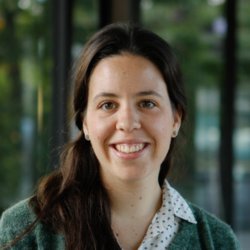Several bachelor programmes at Wageningen University have started to implement learning trajectories for skills education in their curriculum. Claire Goriot, postdoc at WUR, investigates what educational design choices were made in constructing learning trajectories, and what stakeholders’ experiences with the trajectories are.
Constructing learning trajectories
 A learning trajectory is a coherent structure of instructing and learning, across courses and bachelor years (Wijngaards-de Meij & Merx, 2014). ‘At Wageningen University, programmes started implementing learning trajectories for ‘academic writing’, ‘presenting’, and ‘collaboration’, but the university is currently in the process of implementing a much wider set of skills, ranging from ‘dealing with diversity’ to ‘entrepreneurial skills’’, Goriot explains. This research focuses on seven bachelor programmes: Biology, Animal Sciences, Nutrition & Health, Food Technology, Business & Consumer Sciences, Plant Sciences, and Soil, Water, Atmosphere. The aim is to investigate what educational design choices these programmes made in constructing learning trajectories, why they made these choices, and what programme staff’s and students’ experiences with the trajectories are. ‘These insights may help to make recommendations for programmes in- and outside WUR that want to implement learning trajectories in the future’, says Goriot.
A learning trajectory is a coherent structure of instructing and learning, across courses and bachelor years (Wijngaards-de Meij & Merx, 2014). ‘At Wageningen University, programmes started implementing learning trajectories for ‘academic writing’, ‘presenting’, and ‘collaboration’, but the university is currently in the process of implementing a much wider set of skills, ranging from ‘dealing with diversity’ to ‘entrepreneurial skills’’, Goriot explains. This research focuses on seven bachelor programmes: Biology, Animal Sciences, Nutrition & Health, Food Technology, Business & Consumer Sciences, Plant Sciences, and Soil, Water, Atmosphere. The aim is to investigate what educational design choices these programmes made in constructing learning trajectories, why they made these choices, and what programme staff’s and students’ experiences with the trajectories are. ‘These insights may help to make recommendations for programmes in- and outside WUR that want to implement learning trajectories in the future’, says Goriot.
Review study
First, a systematic literature search was conducted. The aim was to get insight in 1) the relevant design choices for skills learning trajectories in higher education as described in the literature, and 2) the success and fail factors that may help or hinder the implementation of learning trajectories. Van den Akker’s (2003) Curricular spider web was used to categorise these design choices. According to this theory, the following ten components of the spider web need to be synchronised in order to optimise students’ learning: educational vision (the core), learning goals, learning content, learning activities, teacher roles, sources & materials, grouping forms, learning environment, time, and assessment.
The results of the study showed that a variety of design choices for learning trajectories exists, and that design choices can be made regarding all components of the spider web. Regarding time, for example, programmes may opt for learning trajectories that are integrated in all three bachelor years, or only in part of the years. And concerning assessment, for instance, programmes may either decide to assess students’ progress in skills development, or students’ actual skill level at the end of the trajectory, or both. The search also revealed success and fail factors for implementation of learning trajectories, which related to five domains: the educational programme, teachers, students, assessment, and tools & artefacts. Goriot: ‘An example is teachers’ fear for or experienced extra workload, which may hamper the implementation and/or execution of learning trajectories’.
Why introduce learning trajectories
The next step was to investigate stakeholders’ experiences with the learning trajectories. Coordinators of the skills learning trajectories and educational directors of the bachelor programmes involved were therefore interviewed. The outcomes of the literature search formed the basis for the interview questions. It became clear that programmes had different reasons for implementing skills learning trajectories. ‘Whereas some programmes mainly wanted to better align skills education that was already present in the curriculum, other programmes’ primary aim was to improve students’ ownership of their learning process’, Goriot points out. The design of the trajectories also differed between programmes. Some programmes opted for a trajectory in which skills education is integrated in content courses and intertwined with content assessment. Other programmes opted for a braided model. In this model, skills education is also integrated in content courses, but next to that these programmes have separate instruction and assessment moments for skills education.
Need for programme skills coordinator
It also became clear that a programme skills coordinator is essential, as (s)he monitors the alignment between skills components in courses and guarantees the future maintenance and development of the learning trajectories. Goriot: ‘Setting up and maintaining learning trajectories appears to ask for a serious investment in time and money to arrange the necessary prerequisites, and this means programmes have to make deliberate choices.’ Furthermore, skills coordinators and programme directors noticed the difficulty of balancing content and skills education in the curriculum: Teachers usually are content experts and now have to make room for skills instruction in their course and sometimes have to deliver that instruction too. The next step is to interview teaching staff and students about their experiences, to collect insights in experiences with skills training both from a teacher and student perspective.
Read more about this project on the 4TU.CEE Innovation map https://www.4tu.nl/cee/innovation/project/13036/skills-learning-trajectories
References
- Akker, J. van den (2003). Curriculum perspectives: an introduction. In J. van den Akker, W. Kuiper & U. Hameyer (eds.). Curriculum Landscapes and Trends (pp. 1-10). Dordrecht:Kluwer Academic Publishers.
- Wijngaards-de Meij, L., & Merx, S. (2016). Improving curriculum alignment and achieving learning goals by making the curriculum visible. International Journal for Academic Development, 23(3), 219-231, doi: https://doi.org/10.1080/1360144X.2018.1462187
Research members
Claire Goriot: claire.goriot@wur.nl
Harm Biemans: harm.biemans@wur.nl
Judith Gulikers: judith.gulikers@wur.nl
Carla Oonk: carla.oonk@wur.nl
Perry den Brok: perry.denbrok@wur.nl



